This article dives deep into neuroplasticity and its profound impact on cognitive growth. This article offers actionable ways to enhance neuroplasticity and the brain's adaptability. Explore cognitive exercises, mindfulness and sensory engagement to promote brain flexibility. Uncover the links between physical activity, nutrition, sleep, and optimal neuroplasticity.
Introduction
Neuroplasticity, also known as brain plasticity or neural plasticity, refers to the brain's ability to reorganize itself by forming new neural connections and modifying existing ones. It can also be called a process that involves adaptive structural and functional changes to the brain. Neuroplasticity has transformed our understanding of the brain, providing a scientific basis for the remarkable resilience and adaptability of the human brain.(1)
The idea of neuroplasticity was first proposed in the early 20th century by Santiago Ramon y Cajal, the father of modern neuroscience.(2) However, it was only in the latter half of the 20th century that the concept gained widespread recognition, thanks to advances in neuroscience research and imaging technology.
Research has shown that the brain constantly changes in response to internal and external stimuli.(3) Every experience, thought, and emotion can alter our brain's structure and function. For example, learning a new skill, such as playing a musical instrument, juggling or speaking a new language, can result in new connections between neurons. At the same time, traumatic events can lead to the loss of connections.
The mechanisms underlying neuroplasticity involve changes in the strength and number of connections between neurons and the formation of new neurons and synapses. A complex interplay of genetic, epigenetic, and environmental factors, including exercise, diet, stress, and social interaction, drives these changes.(4)
One of the most exciting implications of neuroplasticity is that it can be harnessed to promote recovery and rehabilitation after injury or disease. For example, in stroke patients, intensive rehabilitation can promote the growth of new connections in the brain and improve motor function. Similarly, mindfulness-based meditation can reduce the volume of the brain regions that process pain signals in individuals with chronic pain.
Different Types of Neuroplasticity
Neuroplasticity can be broadly broken down into two main mechanisms: structural plasticity and functional plasticity. Regarding an individual's timeline, neuroplasticity can also be divided into two phases – developmental plasticity and adult plasticity. These are two aspects of neuroplasticity that occur at different stages of life.
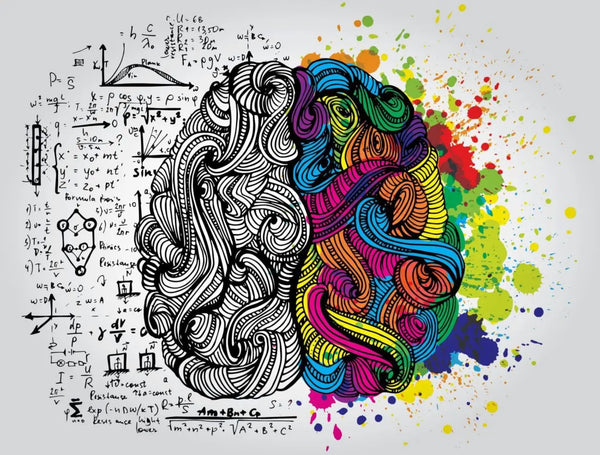
Structural Plasticity
Structural plasticity refers to the physical changes in the brain, such as the formation or elimination of synapses, the growth or retraction of dendritic spines, and the generation or loss of neurons. These changes are thought to underlie the ability of the brain to adapt to new environments and experiences and are particularly important during development when the brain is rapidly growing and changing.(5)
Functional Plasticity
Functional plasticity, on the other hand, refers to changes in the functional properties of neural circuits, such as alterations in the strength of synaptic connections or changes in the pattern of activity in neural networks. These changes underlie the ability of the brain to learn and remember and to adapt to changing cognitive demands and environmental conditions.(6)
Structural and functional plasticity are often interdependent, with changes in one mechanism affecting the other. Both structural and functional plasticity are critical components of neuroplasticity, enabling the brain to adapt and change in response to experience and environmental stimuli.(7)
Developmental Plasticity
Developmental plasticity and adult plasticity are two aspects of neuroplasticity that occur at different stages of life. Developmental plasticity refers to the process of neural plasticity that occurs during the development of the brain, from embryonic development through childhood and adolescence. During this time, the brain is highly malleable and responsive to experience, with neural connections and circuits forming and refining in response to sensory input and environmental stimuli. Developmental plasticity plays a critical role in the brain's normal development, including forming functional neural circuits and establishing critical cognitive and behavioral functions.(8)
Adult Plasticity
In contrast, adult plasticity refers to the ability of the brain to undergo plastic changes in response to experience or injury during adulthood. While the degree of plasticity is generally lower in adulthood than during development, there is still considerable capacity for neural plasticity in the adult brain.
Adult plasticity is the ongoing process of learning and adaptation that occurs throughout the lifespan. It plays a crucial role in maintaining cognitive and behavioral functions in changing environments.(9)
One key difference between developmental plasticity and adult plasticity is the nature of the plastic changes. During development, plasticity often involves forming new synapses, pruning unused connections and the growth and reorganization of dendritic and axonal processes. In contrast, adult plasticity involves the strengthening or weakening of existing connections through changes in synaptic strength and the growth of new connections through the formation of new synapses or the sprouting of new dendritic processes.
The Key Components of Neuroplasticity
1. Synaptic Plasticity
Synaptic plasticity refers to the ability of synapses, the connections between neurons, to change their strength in response to activity. It is a fundamental mechanism underlying learning and memory and forming new neural connections. Synaptic plasticity can occur in both excitatory and inhibitory synapses and is driven by changes in the release of neurotransmitters and the expression of receptors on the postsynaptic membrane.
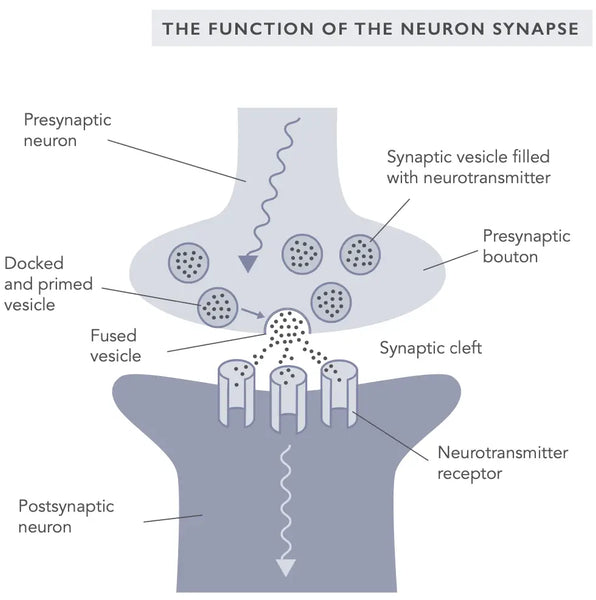
The two most well-studied forms of synaptic plasticity are long-term potentiation (LTP) and long-term depression (LTD), also known as Hebbian plasticity (referring to neuropsychologist Donald Hebb, who first introduced synaptic plasticity in 1949).(10)
LTP is a process by which the strength of a synapse is increased in response to repeated activity. It is thought to underlie the strengthening of neural connections during learning and memory formation. LTD, on the other hand, is a process by which the strength of a synapse is decreased in response to low-frequency or prolonged activity. LTD is thought to play a role in weakening neural connections during forgetting and extinction.(11) Read more about LTP, LTD and memory formation from the Biohacker's Handbook's Mind chapter.
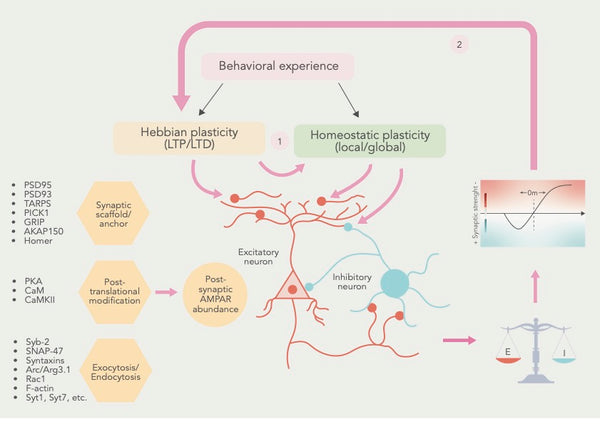
Figure: The co-operative relationship between Hebbian and homeostatic plasticity.
Source: Li, J. & Park, E. & Zhong, L. & Chen, L. (2019). Homeostatic synaptic plasticity as a metaplasticity mechanism—a molecular and cellular perspective. Current Opinion in Neurobiology 54: 44–53.
E= Synaptic excitation I = Synaptic inhibition
In addition to LTP and LTD, many other forms of synaptic plasticity have been identified, including metaplasticity, which refers to changes in the threshold for the induction of LTP and LTD and homeostatic plasticity, which refers to the ability of neurons to adjust their activity in response to changes in network activity.(12)
Putting these forms of synaptic plasticity together, the scientists have concluded that Hebbian and homeostatic synaptic plasticity converge on shared cellular processes and that homeostatic plasticity adjusts the state of synapses to impact Hebbian plasticity (see figure above).
Various molecular and cellular mechanisms regulate synaptic plasticity, including the activity of protein kinases and phosphatases, the synthesis and degradation of proteins and changes in gene expression. These mechanisms are sensitive to various environmental and experiential factors, including sensory input, stress, and social interaction.(13–15)
Neurogenesis
Neurogenesis is the process by which new neurons are generated in the brain, particularly in the hippocampus, a region important for learning and memory. It is a fundamental mechanism underlying the brain's ability to adapt and respond to environmental and experiential factors.
Neurogenesis occurs in the subgranular zone of the hippocampal dentate gyrus, where neural stem cells give rise to intermediate progenitor cells, which in turn give rise to immature neurons. These immature neurons then migrate to the granule cell layer of the hippocampus, where they mature and integrate into the existing neural circuitry. Although new neurons have also been detected in other areas, the extent of neurogenesis in these regions, such as the neocortex and hypothalamus, remains controversial.(16)
The regulation of neurogenesis is a complex and dynamic process influenced by various factors, including genetics, epigenetics, and environmental factors, such as exercise and stress. For example, studies have shown that exercise (particularly aerobic exercise) can stimulate neurogenesis by releasing growth factors such as brain-derived neurotrophic factor (BDNF) and insulin-like growth factor-1 (IGF-1). Conversely, stress and chronic inflammation have been shown to impair neurogenesis via the pro-inflammatory cytokine IL-1β.(17–19)
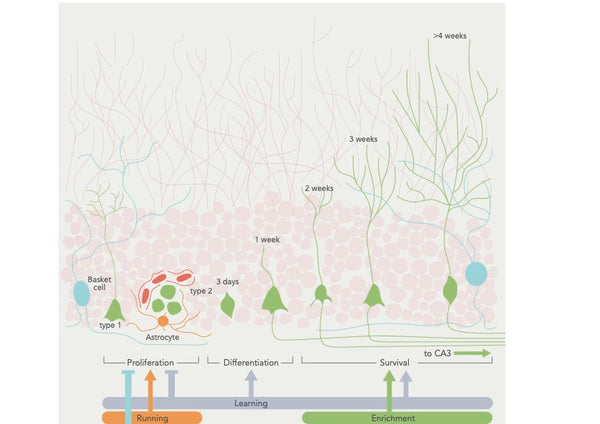
Figure: Regulation of neurogenesis by behavioral factors.
Source: Aimone, J. et al. (2014). Regulation and function of adult neurogenesis: from genes to cognition. Physiological Reviews 94 (4): 991–1026.
The functional role of neurogenesis is still the subject of active research, but it is thought to play a role in learning, memory, mood regulation, and stress response. The study of neurogenesis has important implications for developing new therapies and interventions for neurological and psychiatric conditions.(20–22)
Dendritic Arborization
Dendritic arborization (or dendritic ramification) refers to the process by which dendrites, the branched structures that extend from the cell body of a neuron, develop and elaborate their branching patterns. This process is vital for establishing the connectivity and functional properties of neural circuits in the brain.
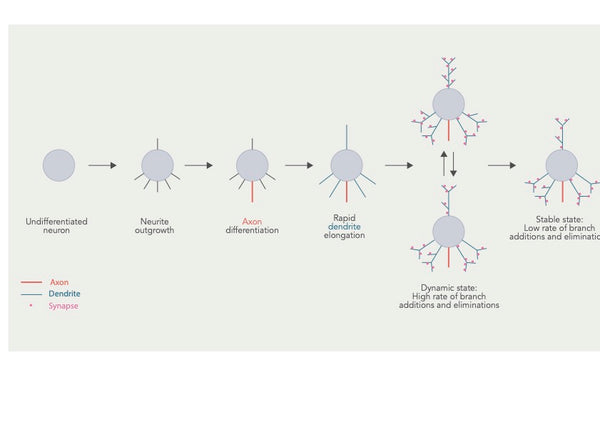 Figure: Development of dendritic arbor and several overlapping stages.
Figure: Development of dendritic arbor and several overlapping stages.
Source: Urbanska, M. & Blazejczyk, M. & Jaworski, J. (2008). Molecular basis of dendritic arborization. Acta Neurobiologiae Experimentalis 68 (2): 264–288.
Dendritic arborization is a complex process regulated by various factors, including genetic and epigenetic factors and environmental factors, such as sensory input and neural activity. The growth and branching of dendrites are driven by the activity of signaling pathways that are activated by extracellular signals, such as growth factors and neurotransmitters. These signals can influence the expression of genes involved in dendritic growth and branching.(23)
The regulation of dendritic arborization is important for establishing and maintaining functional neural circuits in the brain. For example, dendritic arborization is critical for forming synapses, the sites of communication between neurons. The branching patterns of dendrites can influence the types and numbers of synapses formed, which can profoundly impact the functional properties of neural circuits.(24)
Dendritic arborization plays a role in the processing of sensory information. It is also crucial in cognitive functions and memory formation. Specifically, the branching patterns of dendrites can influence the types and numbers of synapses formed, which can profoundly impact the functional properties of neural circuits involved in learning and memory.(25)
Studies have shown that changes in dendritic arborization can occur in response to learning experiences, and these changes are thought to contribute to the formation and maintenance of new memories. For example, training in a spatial memory task in rodents has increased dendritic branching in the hippocampus, a brain region critical for spatial learning and memory.(26)
Moreover, studies have shown that alterations in dendritic arborization are associated with cognitive deficits in neurodegenerative diseases. In Alzheimer's disease, dendritic spines, the structures on dendrites that form synapses with other neurons, are lost in affected brain regions, leading to impaired synaptic plasticity and cognitive deficits.(30)
Myelination
Myelination is a biological process wherein axons, the elongated and slender cellular extensions of neurons that propagate electrical impulses to other neurons, undergo ensheathed with a lipid-rich substance termed myelin. Myelin sheath is produced by oligodendrocytes in the central nervous system (CNS) and Schwann cells in the peripheral nervous system (PNS). Myelin acts as an insulator, allowing electrical signals to travel more quickly and efficiently along axons.(27)
The myelination process begins during embryonic development and continues into early adulthood, with different brain and nervous system regions myelinating at different times. In general, myelination begins in the brainstem and spinal cord and progresses to the cerebral cortex and other higher brain regions.(28) Myelin sheaths typically remain the same length for long periods of time, suggesting that there is not much change in the structure of existing myelin (see image below).(29)
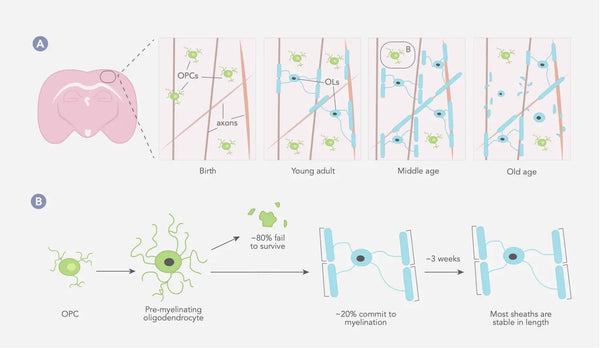
Figure: Oligodendrocyte and myelin dynamics in the mammalian somatosensory cortex throughout life.
Source: Williamson, J. & Lyons, D. (2018). Myelin dynamics throughout life: an ever-changing landscape? Frontiers in Cellular Neuroscience 12: 424.
OPC = Oligodendrocyte precursor cells OLs = Oligodendrocytes
The regulation of myelination is a complex process influenced by various factors, including genetics, epigenetics, and environmental factors, such as experience and neural activity. For example, studies have shown that sensory experience can influence the brain's timing and extent of myelination. Similarly, neural activity can promote myelination by releasing signaling molecules such as BDNF.
Within the central nervous system, the myelination process is activated by axonal activity and astrocytes, while microglia/macrophages are responsible for the clearance of myelin. Once axons have been myelinated, their continued health and functionality rely on providing essential metabolites and neurotrophic factors by glial cells.(31)
The functional role of myelination is critical for the efficient and effective transmission of neural signals in the brain and nervous system. Myelination is key in cognitive and motor functions, including attention, learning and coordination. In addition, myelination is also necessary for developing white matter, the brain's network of axonal connections that allows different brain regions to communicate and coordinate their activities.(32)
Cortical Reorganization
Cortical reorganization, also known as cortical plasticity, refers to the ability of the brain to reorganize its neural networks in response to changes in sensory input or other forms of experience. This process is critical for the development of functional neural circuits and for the ability of the brain to adapt to changes in the environment. Cortical reorganization occurs at multiple brain levels, from the primary sensory areas to higher-level association areas.(33)
The mechanisms underlying cortical reorganization involve changes in synaptic strength and neuronal connectivity. For example, studies have shown that changes in sensory input can lead to changes in the power and number of synapses in the affected cortical regions. Similarly, changes in experience or behavior can lead to changes in the pattern of neural activity and the strength and specificity of synaptic connections.(34)
The functional consequences of cortical reorganization can be beneficial or detrimental. On the one hand, cortical reorganization can enable the brain to adapt to environmental changes and recover from injury or disease. On the other hand, cortical reorganization can also contribute to the development of maladaptive neural circuits and chronic pain syndromes.
Another example is tinnitus, a condition where individuals perceive a ringing or other sound without an external stimulus. Studies have shown that cortical reorganization in the auditory cortex may play a role in the development and maintenance of tinnitus. Specifically, the brain may reorganize in response to damage to the auditory system, leading to the perception of phantom sounds.(35)
Interventions that promote cortical reorganization (e.g., brain plasticity-based therapeutics) may be helpful in the treatment of chronic pain syndromes, stroke and other forms of neurological damage.(36)
Natural Factors That Increase Neuroplasticity
Several natural and technological methods have been shown to promote neuroplasticity and enhance brain function.
Below are listed the best general lifestyle factors to improve neuroplasticity:
- Sleep: Adequate sleep (and deep sleep, in particular) is essential for brain function and has been shown to promote neuroplasticity by enhancing synaptic plasticity and facilitating the consolidation of memories and increasing learning ability.(37–38)
- Exercise: Physical exercise has been shown to increase neuroplasticity by promoting the formation of new neurons, enhancing the growth of dendritic spines, and improving the function of existing neural networks. Aerobic exercise, in particular, has been shown to increase neurotrophic factors (BDNF, NGF and GDNF ), which are proteins that promote the growth and survival of neurons and glial cells.(39–41)
- Meditation: Mindfulness meditation has been shown to promote neuroplasticity by enhancing the density of gray matter in regions of the brain associated with attention, emotion regulation, and self-awareness. It may also improve white matter integrity, which is vital for communication between different brain regions.(42–44)
- Intermittent Fasting: Intermittent fasting, which involves limiting daily food intake to specific hours, enhances neuroplasticity by promoting new neurons' growth and synaptic plasticity. It can also improve cognitive function and reduce the risk of neurodegenerative diseases.(45)
- Intermittent Metabolic Switching (IMS): A lifestyle that involves alternating periods of metabolic stress and recovery, such as fasting and exercise followed by eating, rest and sleep, has been suggested to enhance brain function and resilience. IMS may promote the health and function of the neuronal circuits that support cognitive abilities and emotional well-being throughout life. It broadly impacts multiple signaling pathways that boost neuroplasticity and enhance the brain's resilience against injury and disease.(46)
- Social engagement: Social interaction and engagement have been shown to promote neuroplasticity by enhancing the growth of new neurons and improving the function of existing neural networks. Some studies have suggested that social engagement may even protect against cognitive decline and the onset of neurodegenerative diseases, such as Alzheimer's disease. Therefore, maintaining a strong social network and engaging in regular social activities may be an effective way to support and enhance neuroplasticity throughout the lifespan.(47–48)
- Environmental enrichment: An approach in which an organism's living conditions are optimized to provide diverse sensory, cognitive, and motor stimulation. This strategy has been found to promote neuroplasticity by inducing changes in neural activity and morphology. Specifically, environmental enrichment has been shown to enhance the growth of new neurons, promote synaptic plasticity and improve the function of existing neural networks, resulting in improved cognitive, behavioral and emotional outcomes.(49–50)
- Cognitive training: Activities that challenge the brain to improve brain neuroplasticity. These include learning a new language, playing a musical instrument or solving puzzles – they can enhance neuroplasticity by promoting new neurons' growth and synaptic plasticity.(51–52)
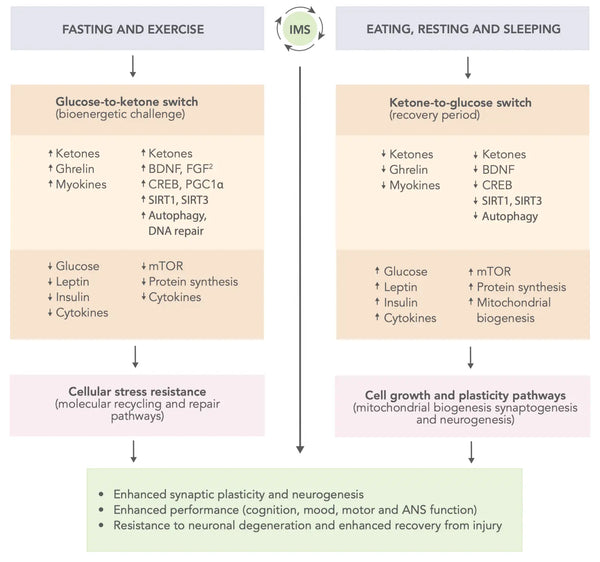
Figure: A schematic model for how intermittent metabolic switching may optimize brain performance and increase resistance to injury and disease.
Source: Mattson, M. & Moehl, K. & Ghena, N. & Schmaedick, M. & Cheng, A. (2018). Intermittent metabolic switching, neuroplasticity and brain health. Nature Reviews Neuroscience 19 (2): 81–94.
Nutritional factors that support neuroplasticity
- Omega-3 Fatty Acids: Long-chain omega-3 fatty acids, especially docosahexaenoic acid (DHA), have been shown to promote neuroplasticity by enhancing synaptic plasticity and increasing the growth of dendritic spines. They may also reduce inflammation in the brain, which can impair neuroplasticity. Sources of omega-3s include fatty fish like salmon and sardines and supplements.(53–55)
- Curcumin: Curcumin, a compound found in turmeric, has been shown to enhance neuroplasticity by promoting the growth of new neurons and strengthening synaptic plasticity. It may also have anti-inflammatory effects, which can improve brain function. Interestingly, curcumin may also reverse impaired cognition and neuronal plasticity induced by chronic stress.(56–57) – Try AGEless Defense supplement that contains B-vitamins, polyphenols, amino acids & curcumin.
- B vitamins: B complex vitamins and choline have been shown to improve brain neuroplasticity. They play a crucial role in various metabolic pathways that support brain function, including synthesizing neurotransmitters and myelin. B vitamins, particularly vitamin B12 and folate, are also involved in DNA methylation, which can affect gene expression in neuroplasticity.(58–62)
- Vitamin D: Some evidence suggests that vitamin D may play a role in promoting neuroplasticity. Vitamin D receptors have been found in various brain regions, including the hippocampus, which is involved in learning and memory. Studies in animals and humans have suggested that vitamin D deficiency may impair cognitive function and decrease the production of specific neurotrophic factors essential for promoting neuroplasticity.(63–64) – Get Ecosh Vitamin K2+D3 to maximize neuroplasticity.
- Polyphenols: Polyphenols have been shown to improve neuroplasticity in the brain. One of the mechanisms is their ability to modulate signaling pathways involved in synaptic plasticity and neurogenesis. They can also exert anti-inflammatory effects and protect against oxidative stress, enhancing neuronal function and promoting neuroplasticity. In general, polyphenols can prevent the progression of neurodegenerative pathologies.(65–66) – Try out one of the best polyphenols: Purovitalis Liposomal Quercetin
Technological methods that support neuroplasticity
- Transcranial Magnetic Stimulation (TMS): TMS is a non-invasive technique that uses magnetic fields to stimulate neural activity in specific brain regions. It has been shown to enhance neuroplasticity and improve cognitive function in various contexts, including in individuals with depression, anxiety and stroke.(67–69) – Get NeoRhythm OmniPEMF neurostimulation device here. [see image below]
- Brain stimulation: Besides TMS, other forms of brain stimulation, such as transcranial direct current stimulation (tDCS) and transcranial alternating current stimulation (tACS), have been shown to enhance neuroplasticity and improve cognitive function.(70–71) Read more about tDCS from the Biohacker’s Handbook.
- Neurofeedback: Neurofeedback is a technique that involves monitoring the brain's electrical activity and providing feedback to the individual in real-time. It has been shown to enhance neuroplasticity by promoting new neurons' growth and synaptic plasticity. Neurofeedback has been used to treat attention deficit hyperactivity disorder (ADHD), anxiety, and other neurological conditions.(72–74) Read more about neurofeedback from the Biohacker’s Handbook.
- Virtual reality (VR): Virtual reality is an immersive technology for training, rehabilitation, and therapeutic purposes. In recent years, increasing interest has been in using VR to enhance brain neuroplasticity. VR can improve neuroplasticity by providing a stimulating and engaging environment that challenges the brain to adapt and learn. For example, VR can simulate real-life scenarios and provide opportunities for learning and practice in a safe and controlled environment. This can help promote new neuron growth and enhance synaptic plasticity.(75–76)
- Cognitive training software: Cognitive training software uses computer programs to improve cognitive function by challenging the brain with memory exercises, problem-solving tasks, and attention tasks. Additionally, mental training can stimulate the release of certain neurotransmitters, such as dopamine and acetylcholine, which can enhance synaptic plasticity and cognitive function and increase BDNF in the brain.(77–79)
Conclusion
In conclusion, the brain's remarkable capacity to reshape itself through various forms of neuroplasticity—developmental, adult, structural, and functional—opens up a world of possibilities for personal growth and cognitive enhancement. Adopting this article's strategies gives you the tools to venture on a transformative journey. You actively shape your brain's future by engaging in mental exercises, cultivating mindfulness and prioritizing healthy habits. Remember, the key lies in consistency and dedication. So, tackle this exciting adventure of opening up to your brain's potential.
If you want to take your game to the next octave, pre-order our massive sequel to the Biohacker's Handbook, the Resilient Being Book.
P.S. This article is based on the text from the Mental Resilience part of the Resilient Being Book.
References:
- Puderbaugh, M. & Emmady, P. (2022). Neuroplasticity. In StatPearls [Internet]. Treasure Island (FL): StatPearls Publishing.
- Venkataramani, P. (2010). Santiago Ramón y Cajal: father of neurosciences. Resonance 15 (11): 968–976.
- Draganski, B. & Gaser, C. & Busch, V. & Schuierer, G. & Bogdahn, U. & May, A. (2004). Changes in grey matter induced by training. Nature 427 (6972): 311–312.
- Kleim, J. & Jones, T. (2008). Principles of experience-dependent neural plasticity: implications for rehabilitation after brain damage. Journal of Speech Language and Hearing Research 51: S225–S239.
- Bozelos, P. & Poirazi, P. (2017). Impact of Structural Plasticity on Memory Capacity. In The Rewiring Brain (pp. 319-341). Cambridge (USA): Academic Press.
- Grafman, J. (2000). Conceptualizing functional neuroplasticity. Journal of Communication Disorders 33 (4): 345–356.
- Taubert, M. et al. (2010). Dynamic properties of human brain structure: learning-related changes in cortical areas and associated fiber connections. Journal of Neuroscience 30 (35): 11670–11677.
- Kolb, B. & Gibb, R. (2011). Brain plasticity and behaviour in the developing brain. Journal of the Canadian Academy of Child and Adolescent Psychiatry 20 (4): 265–276.
- Fuchs, E. & Flügge, G. (2014). Adult neuroplasticity: more than 40 years of research. Neural Plasticity 2014: 541870
- Hebb, D. (1949). The organization of behavior: A neuropsychological theory. New York: John Wiley and Sons.
- Bliss, T. & Collingridge, G. (1993). A synaptic model of memory: long-term potentiation in the hippocampus. Nature 361 (6407): 31–39.
- Li, J. & Park, E. & Zhong, L. & Chen, L. (2019). Homeostatic synaptic plasticity as a metaplasticity mechanism—a molecular and cellular perspective. Current Opinion in Neurobiology 54: 44–53.
- Magee, J. & Grienberger, C. (2020). Synaptic plasticity forms and functions. Annual Review of Neuroscience 43: 95–117.
- Vitureira, N. & De Pasquale, R. & Leão, R. & Rossi, F. (2022). Cellular and molecular mechanisms of synaptic plasticity at hippocampal and cortical synapses. Frontiers in Cellular Neuroscience 16: 980623.
- Fox, K. & Stryker, M. (2017). Integrating Hebbian and homeostatic plasticity: introduction. Philosophical Transactions of the Royal Society B: Biological Sciences 372 (1715): 20160413.
- Aimone, J. et al. (2014). Regulation and function of adult neurogenesis: from genes to cognition. Physiological Reviews 94 (4): 991–1026
- Cotman, C. & Berchtold, N. (2002). Exercise: a behavioral intervention to enhance brain health and plasticity. Trends in Neurosciences 25 (6): 295–301.
- Vecchio, L. et al. (2018). The neuroprotective effects of exercise: maintaining a healthy brain throughout aging. Brain Plasticity 4 (1): 17–52.
-
Saxe, M. et al. (2006). Ablation of hippocampal neurogenesis impairs contextual fear conditioning and synaptic plasticity in the dentate gyrus. Proceedings of the National Academy of Sciences 103 (46): 17501–17506.
- Aimone, J. et al. (2014). Regulation and function of adult neurogenesis: from genes to cognition. Physiological Reviews 94 (4): 991–1026.
- Ming, G. & Song, H. (2011). Adult neurogenesis in the mammalian brain: significant answers and significant questions. Neuron 70 (4): 687–702.
- Urbanska, M. & Blazejczyk, M. & Jaworski, J. (2008). Molecular basis of dendritic arborization. Acta Neurobiologiae Experimentalis 68 (2): 264–288.
- Cline, H. (2001). Dendritic arbor development and synaptogenesis. Current Opinion In Neurobiology 11 (1): 118–126.
- Kasai, H. & Fukuda, M. & Watanabe, S. & Hayashi-Takagi, A. & Noguchi, J. (2010). Structural dynamics of dendritic spines in memory and cognition. Trends in Neurosciences 33 (3): 121–129.
- Holtmaat, A. & Svoboda, K. (2009). Experience-dependent structural synaptic plasticity in the mammalian brain. Nature Reviews Neuroscience 10 (9): 647–658.
- Demerens, C. et al. (1996). Induction of myelination in the central nervous system by electrical activity. Proceedings of the National Academy of Sciences 93 (18): 9887–9892.
- Harry, G. & Toews, A. (1998). Myelination, dysmyelination, and demyelination. Handbook of Developmental Neurotoxicology 87–115.
- Williamson, J. & Lyons, D. (2018). Myelin dynamics throughout life: an ever-changing landscape? Frontiers in Cellular Neuroscience 12: 424.
- Scheff, S. & Price, D. & Schmitt, F. & Mufson, E. (2006). Hippocampal synaptic loss in early Alzheimer's disease and mild cognitive impairment. Neurobiology of Aging 27 (10): 1372–1384.
- Nave, K. & Werner, H. (2014). Myelination of the nervous system: mechanisms and functions. Annual Review of Cell and Developmental Biology 30: 503–533
- Fields, R. (2015). A new mechanism of nervous system plasticity: activity-dependent myelination. Nature Reviews Neuroscience 16 (12): 756–767.
- Pascual-Leone, A. & Amedi, A. & Fregni, F. & Merabet, L. (2005). The plastic human brain cortex. Annual Reviews Neuroscience 28: 377–401.
- Schoups, A. & Vogels, R. & Qian, N. & Orban, G. (2001). Practising orientation identification improves orientation coding in V1 neurons. Nature 412 (6846): 549–553.
- Mühlnickel, W. & Elbert, T. & Taub, E. & Flor, H. (1998). Reorganization of auditory cortex in tinnitus. Proceedings of the National Academy of Sciences 95 (17): 10340–10343.
- Merzenich, M. & Van Vleet, T. & Nahum, M. (2014). Brain plasticity-based therapeutics. Frontiers in Human Neuroscience 8: 385.
- Fattinger, S. et al. (2017). Deep sleep maintains learning efficiency of the human brain. Nature Communications 8 (1): 15405.
- Voss, M. et al. (2010). Plasticity of brain networks in a randomized intervention trial of exercise training in older adults. Frontiers in Aging Neuroscience 2: 32.
- e Sousa Fernandes, M. et al. (2020). Effects of physical exercise on neuroplasticity and brain function: a systematic review in human and animal studies. Neural Plasticity 2020: 8856621
- Hölzel, B. et al. (2011). Mindfulness practice leads to increases in regional brain gray matter density. Psychiatry Research: Neuroimaging 191 (1): 36–43.
- Tang, Y. & Hölzel, B. K. & Posner, M. (2015). The neuroscience of mindfulness meditation. Nature Reviews Neuroscience 16 (4): 213–225.
- Lardone, A. et al. (2018). Mindfulness meditation is related to long-lasting changes in hippocampal functional topology during resting state: a magnetoencephalography study. Neural Plasticity 2018: 5340717.
- Brocchi, A. & Rebelos, E. & Dardano, A. & Mantuano, M. & Daniele, G. (2022). Effects of intermittent fasting on brain metabolism. Nutrients 14 (6): 1275.
- Mattson, M. & Moehl, K. & Ghena, N. & Schmaedick, M. & Cheng, A. (2018). Intermittent metabolic switching, neuroplasticity and brain health. Nature Reviews Neuroscience 19 (2): 81–94.
- Kramer, A. & Bherer, L. & Colcombe, S. & Dong, W. & Greenough, W. (2004). Environmental influences on cognitive and brain plasticity during aging. The Journals of Gerontology Series A: Biological Sciences and Medical Sciences 59 (9): M940–M957.
- Fratiglioni, L. & Paillard-Borg, S. & Winblad, B. (2004). An active and socially integrated lifestyle in late life might protect against dementia. The Lancet Neurology 3 (6): 343–353.
- Kempermann, G. (2015). Activity dependency and aging in the regulation of adult neurogenesis. Cold Spring Harbor Perspectives in Biology 7 (11): a018929.
- Van Praag, H. & Kempermann, G. & Gage, F. (2000). Neural consequences of enviromental enrichment. Nature Reviews Neuroscience 1 (3): 191–198
- Lövdén, M. & Bäckman, L. & Lindenberger, U. & Schaefer, S. & Schmiedek, F. (2010). A theoretical framework for the study of adult cognitive plasticity. Psychological Bulletin 136 (4): 659–676
- Park, D. & Bischof, G. (2013). The aging mind: neuroplasticity in response to cognitive training. Dialogues in Clinical Neuroscience 15 (1): 109–119.
- Crupi, R. & Marino, A. & Cuzzocrea, S. (2013). n-3 fatty acids: role in neurogenesis and neuroplasticity. Current Medicinal Chemistry 20 (24): 2953–2963.
- Swanson, D. & Block, R. & Mousa, S. A. (2012). Omega-3 fatty acids EPA and DHA: health benefits throughout life. Advances in Nutrition 3 (1): 1–7.
- Dyall, S. (2015). Long-chain omega-3 fatty acids and the brain: a review of the independent and shared effects of EPA, DPA and DHA. Frontiers in Aging Neuroscience 7: 52.
- Maharjan, R. et al. (2020). Role of lifestyle in neuroplasticity and neurogenesis in an aging brain. Cureus 12 (9): e10639.
- Xu, Y. et al. (2009). Curcumin reverses impaired cognition and neuronal plasticity induced by chronic stress. Neuropharmacology 57 (4): 463–471.
- Echeverry, M. et al. (2021). Vitamins D and B 12, Altered Synaptic Plasticity and Extracellular Matrix. In B-Complex Vitamins-Sources, Intakes and Novel Applications. IntechOpen.
- Downey, L. et al. (2019). Increased posterior cingulate functional connectivity following 6-month high-dose B-vitamin multivitamin supplementation: a randomized, double-blind, placebo-controlled trial. Frontiers in Nutrition 6: 156.
- Mattson, M. & Shea, T. (2003). Folate and homocysteine metabolism in neural plasticity and neurodegenerative disorders. Trends in Neurosciences 26 (3): 137–146.
- Chin, E. & Goh, E. (2019). Modulating neuronal plasticity with choline. Neural Regeneration Research 14 (10): 1697.
- Jadavji, N. & Emmerson, J. & MacFarlane, A. & Willmore, W. & Smith, P. (2017). B-vitamin and choline supplementation increases neuroplasticity and recovery after stroke. Neurobiology of Disease 103: 89–100.
- Mayne, P. & Burne, T. (2019). Vitamin D in synaptic plasticity, cognitive function, and neuropsychiatric illness. Trends in Neurosciences 42 (4): 293–306.
- Echeverry, M. et al. (2021). Vitamins D and B 12, Altered Synaptic Plasticity and Extracellular Matrix. In B-Complex Vitamins-Sources, Intakes and Novel Applications. IntechOpen.
- Vauzour, D. (2012). Dietary polyphenols as modulators of brain functions: biological actions and molecular mechanisms underpinning their beneficial effects. Oxidative Medicine and Cellular Longevity 2012: 914273.
- Figueira, I. & Menezes, R. & Macedo, D. & Costa, I. & Nunes dos Santos, C. (2017). Polyphenols beyond barriers: a glimpse into the brain. Current Neuropharmacology 15 (4): 562–594.
- Hallett, M. (2007). Transcranial magnetic stimulation: a primer. Neuron 55 (2): 187–199.
- Jannati, A. & Oberman, L. & Rotenberg, A. & Pascual-Leone, A. (2023). Assessing the mechanisms of brain plasticity by transcranial magnetic stimulation. Neuropsychopharmacology 48 (1): 191–208.
- Auriat, A. & Neva, J. & Peters, S. & Ferris, J. & Boyd, L. (2015). A review of transcranial magnetic stimulation and multimodal neuroimaging to characterize post-stroke neuroplasticity. Frontiers in Neurology 6: 226.
- Kricheldorff, J. et al. (2022). Evidence of Neuroplastic Changes after Transcranial Magnetic, Electric, and Deep Brain Stimulation. Brain Sciences 12 (7): 929.
- Brunoni, A. et al. (2012). Clinical research with transcranial direct current stimulation (tDCS): challenges and future directions. Brain Stimulation 5 (3): 175–195.
- Gruzelier, J. (2014). EEG-neurofeedback for optimising performance. III: a review of methodological and theoretical considerations. Neuroscience & Biobehavioral Reviews 44: 159–182.
- Trambaiolli, L. & Cassani, R. & Mehler, D. & Falk, T. (2021). Neurofeedback and the aging brain: a systematic review of training protocols for dementia and mild cognitive impairment. Frontiers in Aging Neuroscience 13: 682683.
- Sitaram, R. et al. (2017). Closed-loop brain training: the science of neurofeedback. Nature Reviews Neuroscience 18 (2): 86–100.
- Laver, K. & George, S. & Thomas, S. & Deutsch, J. & Crotty, M. (2015). Virtual reality for stroke rehabilitation: an abridged version of a Cochrane review. European Journal of Physical and Rehabilitation Medicine 51 (4): 497–506.
- Huang, C. et al. (2022). Effects of virtual reality-based motor control training on inflammation, oxidative stress, neuroplasticity and upper limb motor function in patients with chronic stroke: a randomized controlled trial. BMC Neurology 22 (1): 21.
- Anguera, J. et al. (2013). Video game training enhances cognitive control in older adults. Nature 501 (7465): 97–101.
- Lampit, A. et al. (2014). The timecourse of global cognitive gains from supervised computer-assisted cognitive training: a randomised, active-controlled trial in elderly with multiple dementia risk factors. The Journal of Prevention of Alzheimers Disease 1 (1): 33–39.
- D'Antonio, J. et al. (2019). Cognitive training and neuroplasticity in mild cognitive impairment (COG-IT): protocol for a two-site, blinded, randomised, controlled treatment trial. BMJ Open 9 (8): e028536.







